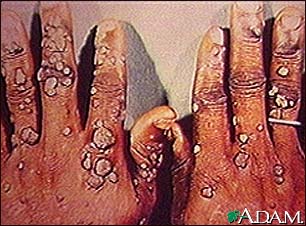Treatment
Over-the-counter medications can remove warts. These are applied to the wart every day for several weeks. DO NOT use these medications on your face or genitals. It helps to file the wart down when damp (for example, after a bath or shower) before applying these medications. DO NOT treat warts on your face or genitals yourself. See your health care provider.
Pain and pressure from plantar warts can be treated with special cushions that are available at drug stores.
Your health care provider may use stronger (prescription) medications, such as podophylin or salicylic acid, for removal of persistent warts. Surgical removal or removal by freezing (cryotherapy), burning (electrocautery), or laser treatment may be needed.
Immunotherapy, done by injecting a substance that causes an allergic reaction, may also be considered by your health care provider. A topical medication called imiquimod may also be used.
A vaccine called Gardasil prevents infection against the strains of viruses that often cause genital warts and cervical cancer in women.
DO NOT attempt to remove a wart yourself by burning, cutting, tearing, picking, or any other method.
Prognosis (Expectations)
Warts are generally harmless growths that often go away on their own within 2 years. They can be contagious, but transmission from person to person is uncommon. Warts may be unsightly or cause discomfort, especially on the feet.
Complications
- Spread of warts
- Return of warts that disappeared
- Minor scar formation if the wart is removed
- Formation of keloids after removal
Calling Your Health Care Provider
Call for an appointment with your doctor if:
- There are signs of infection (red streaking, pus, discharge, or fever) or bleeding. Warts can bleed a little, but if bleeding is significant or not easily stopped by light pressure, see a doctor.
- The wart does not respond to self-care and you want it removed.
- You have pain associated with the wart.
- You have anal or genital warts.
- You have diabetes or a weakened immune system (for example, HIV) and have developed warts.
- There is any change in the color or appearance of the wart.
-

Review Date : 12/11/2009
Reviewed By : Kevin Berman, MD, PhD, Atlanta Center for Dermatologic Disease, Atlanta, GA. Review provided by VeriMed Healthcare Network. Also reviewed by David Zieve, MD, MHA, Medical Director, A.D.A.M., Inc.
